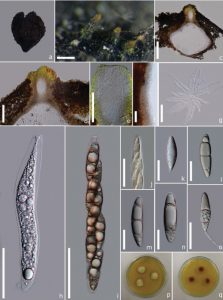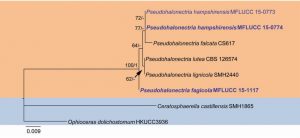Pseudohalonectria hampshirensis R.H. Perera, E.B.G. Jones & K.D. Hyde, sp. nov., Index Fungorum number: IF 552162, Fig. 1a–q.
Etymology: Refers to the county, Hampshire where the holotype was collected.
Holotype: MFLU 16-1086
Saprobic on beech cupules (Fagus sylvatica L.). Sexual morph: Ascomata 360–800 × 350–720 μm, solitary to less commonly aggregated, immersed with a long neck, globose to depressed globose, greenish yellow at first, becoming darkened with age. Neck 311 –632 × 53–192 μm, long, cylindrical to conical, composed of parallel hyphae, outer hyphae outwardly directed, subglobose with enlarged ends, greenish yellow, periphysate. Peridium membranous, comprising 6–10 cell layers, inner layers composed of pale yellow cells of textura angularis, outer layer composed of darkened yellow compressed cells of textura angularis. Paraphyses 40–95 × 5.1–9.3 μm, 1–4(–5)-septate, wide at the base, tapering towards the apex, thin-walled, attached to ascogenous hyphae. Asci 143–196 × 16–24 μm diam. (x̅ = 196 × 24 μm, n = 30), 8-spored, unitunicate, cylindrical, straight or curved, with J-, thimble-shaped, apical ring, separating at the basal septum from ascogenous hyphae. Ascospores 29–57 × 7–14 (x̅ = 45 × 11, n = 30) μm, overlapping uniseriate to biseriate, pale brown, long ellipsoidal with bluntly rounded ends, straight, 0–3 (–4)-septate, constricted or not-constricted at the septa, after discharge accumulating in a mass at the neck opening. Asexual morph: Undetermined.
Culture characters: Slow growing, reaching 2.7 cm within 21 days on PDA, at 16 °C, circular, effuse, with regular margin, yellowish-green in center and hyaline towards the margin from above; reverse yellow green to
brown.
Material examined: UK, Hampshire, Bishops Waltham, slightly anoxic, stagnant water, on beech cupules (Fagus sylvatica L.), 3 June 2015, E.B.G. Jones, GJ 177 (MFLU 16-1086, holotype); ibid. (GZ, isotype); ex-type living cultures MFLUCC 15-0774, GZCC; UK, Hampshire, Bishops Waltham, slightly anoxic, stagnant water, embedded in unidentified decaying wood, 3 June 2015, E.B.G. Jones, GJ 168 (MFLU 16-1077, paratype), ex-paratype living culture MFLUCC 15-0773, GZCC.
Notes: Pseudohalonectria hampshirensis is a distinct species in the genus as supported by molecular and morphological characters. In the phylogenetic analysis, P. hampshirensis grouped with P. falcata (Fig. 2). However, morphologically P. hampshirensis is different from P. falcata. Ascomata of P. falcata are smaller (277–535 μm) than P. hampshirensis (360–800 × 350–720 μm). Ascospores of P. hampshirensis are shorter (29–57 × 7–14 μm), fusiform and 0–3 (–4) septate, while P. falcata has longer (97–166 × 4.2–7.2 μm), falcate, 6–16-septate ascospores (Shearer 1989). Morphologically P. hampshirensis differs from other Pseudohalonectria species in the size of the ascomata, asci, ascospores and ascospore septation.

Fig. 1. Pseudohalonectria hampshirensis (MFLU 16-1086, holotype) a, b. Appearance of ascomata on host substrate. c, d. Longitudinal section through ascoma. e. Close up of the base of neck f. Close up of the peridium. g. Paraphyses. h, i. Immature and mature asci. j. Ascus in Melzer’s reagent. k–n. Ascospores. o. Germinating ascospore. p, q. Cultures on MEA. Bars: b, c = 200 μm, d–f = 100 μm, g–j = 50 μm, k–n = 20 μm.

Fig. 2. Phylogram generated from maximum likelihood analysis based on combined LSU and SSU sequence data of the genus Pseudohalonectria. Maximum likelihood bootstrap support values greater than 50% and Bayesian posterior probabilities (PP) above 95% are shown near the nodes. The new isolates are in blue and ex-type sequences in bold. The tree is rooted with Ophioceras dolichostomum and Ceratosphaerella castillenses.
